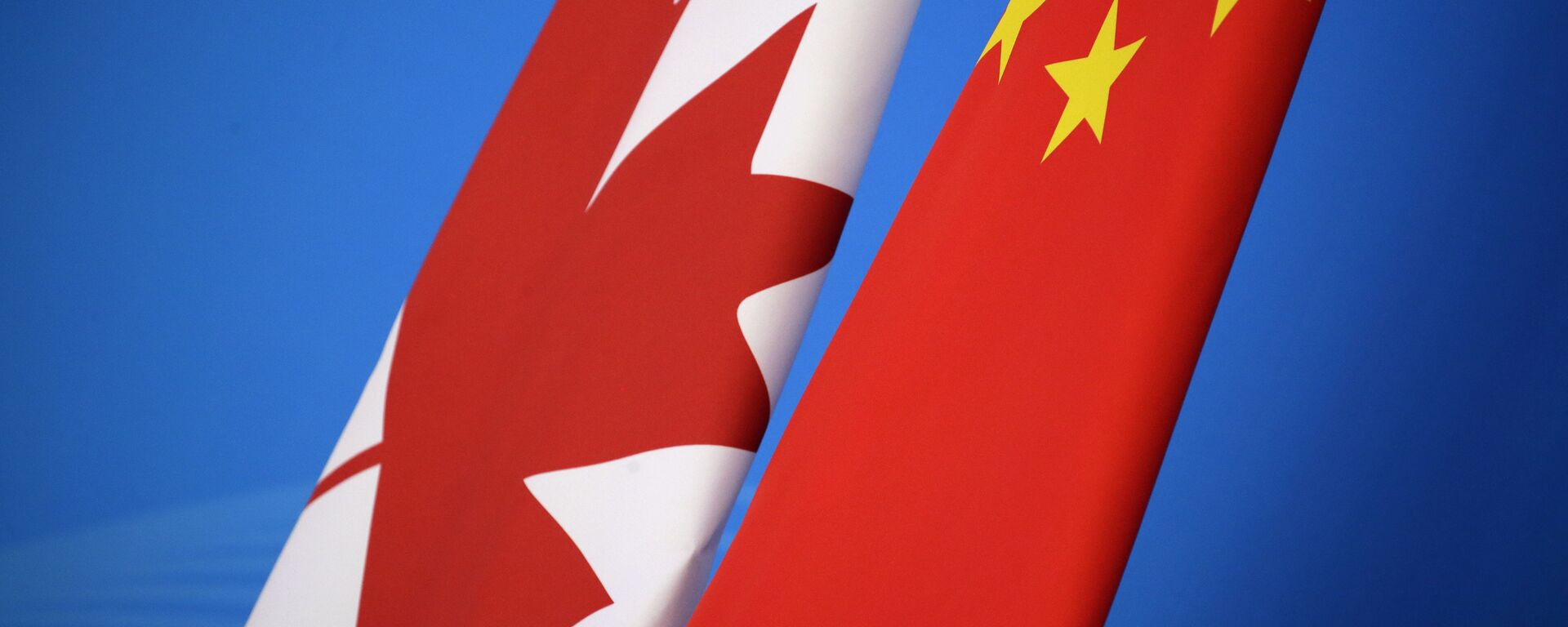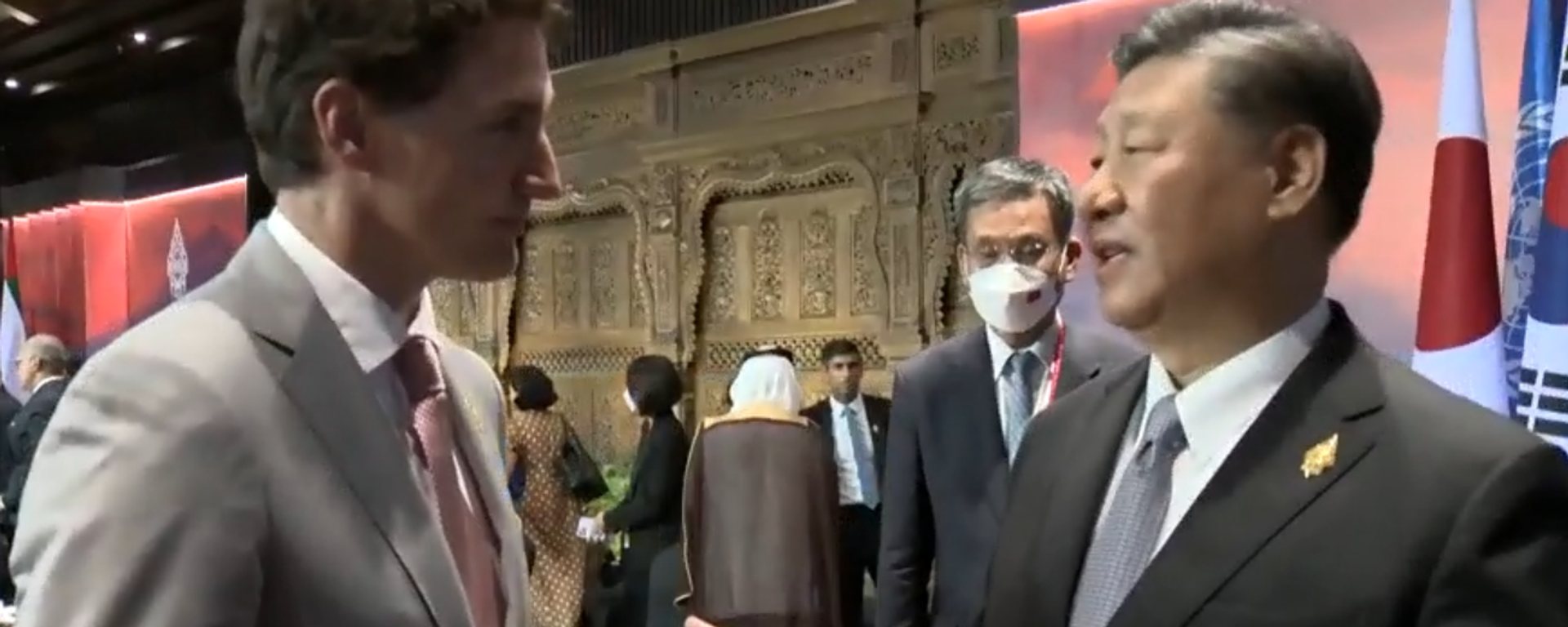https://sputnikglobe.com/20221127/canada-plans-to-grow-military-footprint-in-asia-as-part-of-multi-billion-dollar-anti-china-strategy-1104764371.html
Canada Plans to Grow Military Footprint in Asia as Part of Multi-Billion-Dollar Anti-China Strategy
Canada Plans to Grow Military Footprint in Asia as Part of Multi-Billion-Dollar Anti-China Strategy
Sputnik International
Relations between Ottawa and Beijing have been strained by back-and-forth trade and technology battles, allegations of alleged human rights violations, and... 27.11.2022, Sputnik International
2022-11-27T19:10+0000
2022-11-27T19:10+0000
2022-11-28T03:50+0000
canada
china
justin trudeau
strategy
asia-pacific region
military
https://cdn1.img.sputnikglobe.com/img/107599/12/1075991279_0:69:1534:932_1920x0_80_0_0_e438735a0e3a44845ed7f9202a473f3b.png
Ottawa unveiled a new ‘Indo-Pacific Strategy’ on Sunday which commits billions of dollars to building up Canada’s military footprint, intelligence cooperation and economic ties with Asian countries in a bid to contain a rising China.The 26-page document, released to Canadian and US media, characterizes “China’s rise” as a challenge to Ottawa and its allies, with Beijing accused of seeking “to shape the international order into a more permissive environment for interests and values that increasingly depart from ours.” The paper promises that Canada will “unapologetically defend our national interest” when necessary, and approach its assessment of the Asian nation in a “realistic and clear-eyed” manner from here on out.“China’s sheer size and influence makes cooperation necessary to address some of the world’s existential pressures, such as climate change and biodiversity loss, global health and nuclear proliferation,” the paper says.The government commitment includes $2.3 billion Canadian in initial investment to safeguard Canada’s “infrastructure and democracy” against foreign interference, ramp up Canadian naval patrols in Asia, and efforts to “increase our military engagement and intelligence capability as a means of mitigating coercive behavior and threats to regional security.” This includes over $500 million Canadian for defense, plus investments in intelligence and cybersecurity, including for the Royal Canadian Mounted Police and the Canadian Security Intelligence Service (CSIS).The document also enshrines Canada’s opposition to “unilateral actions that threaten the status quo in the Taiwan Strait,” and outlines plans to deploy frigates in the region, not only to contain China, but to enforce sanctions against North Korea.The paper also includes references to the need to improve economic ties with India and other Asian nations, including Indonesia and Malaysia, including through a $750 million investment in ‘sustainable infrastructure projects’, and calls for the strengthening of ties with Japan and South Korea.Nearly half a century of cordial relations between Canada and China took a turn for the worse in 2018, when the Canadian government arrested the chief financial officer of Chinese tech giant Huawei at Washington’s behest over alleged sanctions violations. Tensions have escalated further in the years that followed, with the nations leveling back and forth sanctions against one another and exchanging acrimony over the alleged mistreatment of one another’s minorities. Canada’s decision to ban Huawei and ZTE from its 5G infrastructure, and the Trudeau government’s recent claims that China meddled in Canada’s 2019 elections, have further stoked tensions.Despite the rhetoric, the two countries remains heavily intertwined economically, with Canada importing $85.6 billion worth of goods and services from China in 2021, and exporting $28.8 billion to the Asian country. The People’s Republic is Canada’s second largest trade partner after the United States.
https://sputnikglobe.com/20221119/canada-will-boost-military-presence-in-indo-pacific-will-challenge-china-when-it-ought-to-1104433543.html
https://sputnikglobe.com/20221117/3-reasons-chinas-xi-was-right-to-chide-canadas-trudeau-over-talks-leaked-to-media-1104330972.html
canada
china
Sputnik International
feedback@sputniknews.com
+74956456601
MIA „Rossiya Segodnya“
2022
News
en_EN
Sputnik International
feedback@sputniknews.com
+74956456601
MIA „Rossiya Segodnya“
Sputnik International
feedback@sputniknews.com
+74956456601
MIA „Rossiya Segodnya“
canada, china, asia-pacific, strategy, strategy document, paper, government paper
canada, china, asia-pacific, strategy, strategy document, paper, government paper
Canada Plans to Grow Military Footprint in Asia as Part of Multi-Billion-Dollar Anti-China Strategy
19:10 GMT 27.11.2022 (Updated: 03:50 GMT 28.11.2022) Relations between Ottawa and Beijing have been strained by back-and-forth trade and technology battles, allegations of alleged human rights violations, and, most recently, the leak of the contents of confidential talks between Prime Minister Justin Trudeau and Chinese President Xi Jinping at the G20 Summit.
Ottawa unveiled a new ‘Indo-Pacific Strategy’ on Sunday which commits billions of dollars to building up Canada’s military footprint, intelligence cooperation and economic ties with Asian countries in a bid to contain a rising China.
The 26-page document, released to Canadian and US media,
characterizes “China’s rise” as a challenge to Ottawa and its allies, with Beijing accused of seeking “to shape the international order into a more permissive environment for interests and values that increasingly depart from ours.” The paper promises that Canada will “unapologetically defend our national interest” when necessary, and approach its assessment of the Asian nation in a “realistic and clear-eyed” manner from here on out.
“China’s sheer size and influence makes cooperation necessary to address some of the world’s existential pressures, such as climate change and biodiversity loss, global health and nuclear proliferation,” the paper says.
However, “in areas of profound disagreement, we will challenge China, including when it engages in coercive behavior – economic or otherwise – ignores human rights obligations or undermines our national security interests and those of partners in the region,” the document says.
The government commitment includes $2.3 billion Canadian in initial investment to safeguard Canada’s “infrastructure and democracy” against foreign interference, ramp up Canadian naval patrols in Asia, and efforts to “increase our military engagement and intelligence capability as a means of mitigating coercive behavior and threats to regional security.” This includes over $500 million Canadian for defense, plus investments in intelligence and cybersecurity, including for the Royal Canadian Mounted Police and the Canadian Security Intelligence Service (CSIS).

19 November 2022, 14:12 GMT
The document also enshrines Canada’s opposition to “unilateral actions that threaten the status quo in the Taiwan Strait,” and outlines plans to deploy frigates in the region, not only to contain China, but to enforce sanctions against North Korea.
The paper also includes references to the need to improve economic ties with India and other Asian nations, including Indonesia and Malaysia, including through a $750 million investment in ‘sustainable infrastructure projects’, and calls for the strengthening of ties with Japan and South Korea.
In an interview with US media ahead of the strategy’s publication, Foreign Affairs Minister Joly pointed to shifts in the world’s geopolitical “tectonic plates” which she said posed a threat to the existing world order. “When it comes to China, we know that there’s a battle of influence happening in the region. So we have to step up our game,” Joly
said.
Nearly half a century of cordial relations between Canada and China took a turn for the worse in 2018, when the Canadian government arrested the chief financial officer of Chinese tech giant Huawei at Washington’s behest over alleged sanctions violations. Tensions have escalated further in the years that followed, with the nations leveling back and forth sanctions against one another and exchanging acrimony over the alleged mistreatment of one another’s minorities. Canada’s decision to ban Huawei and ZTE from its 5G infrastructure, and the Trudeau government’s recent claims that China meddled in Canada’s 2019 elections, have further stoked tensions.
Despite the rhetoric, the two countries remains heavily intertwined economically, with Canada importing $85.6 billion worth of goods and services from China in 2021, and exporting $28.8 billion to the Asian country. The People’s Republic is Canada’s second largest trade partner after the United States.

17 November 2022, 12:21 GMT




